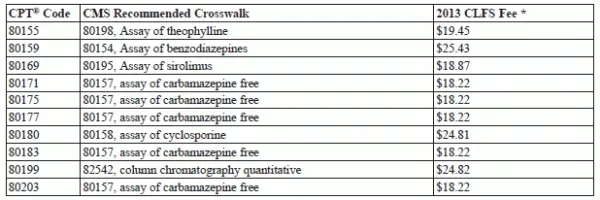Pathology/Lab Coding Alert
10 Reasons to Update Therapeutic Drug Assay Codes
See what you can expect for payment, too.
When physicians order quantitative assays for therapeutic drug monitoring purposes, you’ll have some brand new codes to use beginning Jan. 1, 2014.
Read on to make sure your lab is ready to start using analyte-specific codes when the new year rolls around, in place of the more generic codes you’ve been using.
Know When to Use Therapeutic Drug Assay Codes
Not every drug test justifies reporting a code from the “therapeutic drug assays” CPT® section. You should reserve these codes for quantitative testing and turn instead to “drug testing” codes 80100-80104 for qualitative screening, according to Robin Miller Zweifel, MT (ASCP), a laboratory coding and billing compliance consultant in Niota, Tenn.
Physicians often order therapeutic drug assays to evaluate patients taking medications. The assays aid the physician in evaluating clinical scenarios, such as:
Learn the New Codes
CPT® 2014 introduces the following 10 codes in the therapeutic drug assay section:
Physicians may monitor serum levels as adjunctive therapy for seizures.
Check the Pricing Proposal
After receiving input from industry stakeholders at the annual Clinical Laboratory Fee Schedule (CLFS) public meeting earlier this year, CMS determined the basis of payment and posted the recommendations online, as explained by CMS meeting coordinator Glenn McGuirk.
Study the following table to see the CMS-recommended crosswalks and the current payment rate for those codes.
*National limit amount
The CMS payment recommendations for these new codes represent the view point of several presenters at the annual CMS meeting. For instance, specific crosswalks were recommended for the 10 new codes “based on existing drug codes that have similar analytical methods and clinical uses,” said Greg Root, speaking on behalf of the American Association for Clinical Chemistry.
Other commentators had urged CMS to use two methodology codes for the payment basis, as follows, depending on the new code test method:
CMS followed this recommendation for 80199, but opted for similar drug codes rather than method codes for all other CPT® 2014 therapeutic drug assay code additions.
Update billing codes: For the 10 new anaylte-specific tests, most labs would currently report 80299 (Quantitation of drug, not elsewhere specified). Don’t forget to shift to the new, more specific codes when they go into effect on Jan. 1.

Pathology/Lab Coding Alert
- CPT® 2014:
81057, 87661: These Codes May Have Ob/Gyn Clients Calling
Fetal evaluations and STD infection diagnosis at stake. You might see more lab test orders [...] - ICD-10:
Trichomoniasis Boasts Direct Crosswalk
Organism and infection site focus codes. Coding urogenital Trichomonas infections won’t change much when your [...] - CPT® 2014:
10 Reasons to Update Therapeutic Drug Assay Codes
See what you can expect for payment, too. When physicians order quantitative assays for therapeutic [...] - Modifier Update:
Avoid Pitfalls of 59 Overuse
Look to 91 or 76 in some cases. Rumor has it that Medicare no longer [...] - You Be the Coder:
Capture Polarizing Microscopy Service
Question: The pathologist examined a bursa fluid aspirate smear from the left elbow, identifying reactive [...] - Reader Question:
Distinguish Surgery from Pathology Procedure
Question:Our pathologist examined a “shave biopsy,” and when I spoke to the doctor’s office to [...] - Reader Question:
Modifier PT is Out for Pathology
Question: We billed 88305 and 88342 with modifier PT for a diagnosis of V76.51 and [...] - Reader Question:
Whooping Cough Test Code is in the Details
Question: Due to increased number of whooping cough cases, we’re starting to perform a screening [...] - Reader Question:
Distinguish Cyst, Neoplasm
Question: What are the correct diagnosis and procedure codes for a hair follicle excision specimen [...]

